Museum of London: History, Structure, Objectives, Sustainability and Funding
VerifiedAdded on 2023/01/19
|16
|3185
|65
AI Summary
This report provides an overview of the Museum of London, including its history, structure, objectives, sustainability efforts, and funding sources. It also discusses the key stakeholders and their power and interest in the organization.
Contribute Materials
Your contribution can guide someone’s learning journey. Share your
documents today.
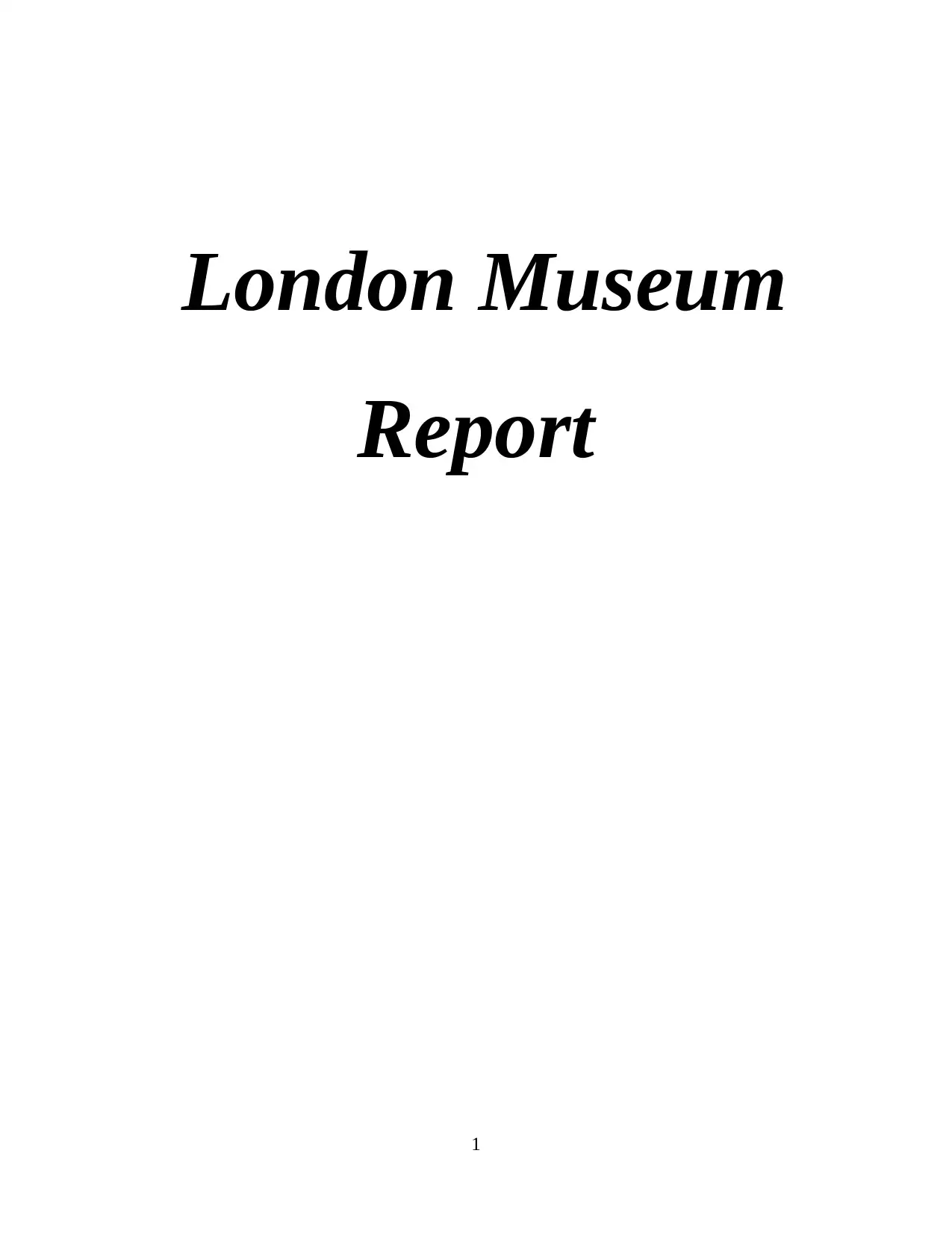
London Museum
Report
1
Report
1
Secure Best Marks with AI Grader
Need help grading? Try our AI Grader for instant feedback on your assignments.
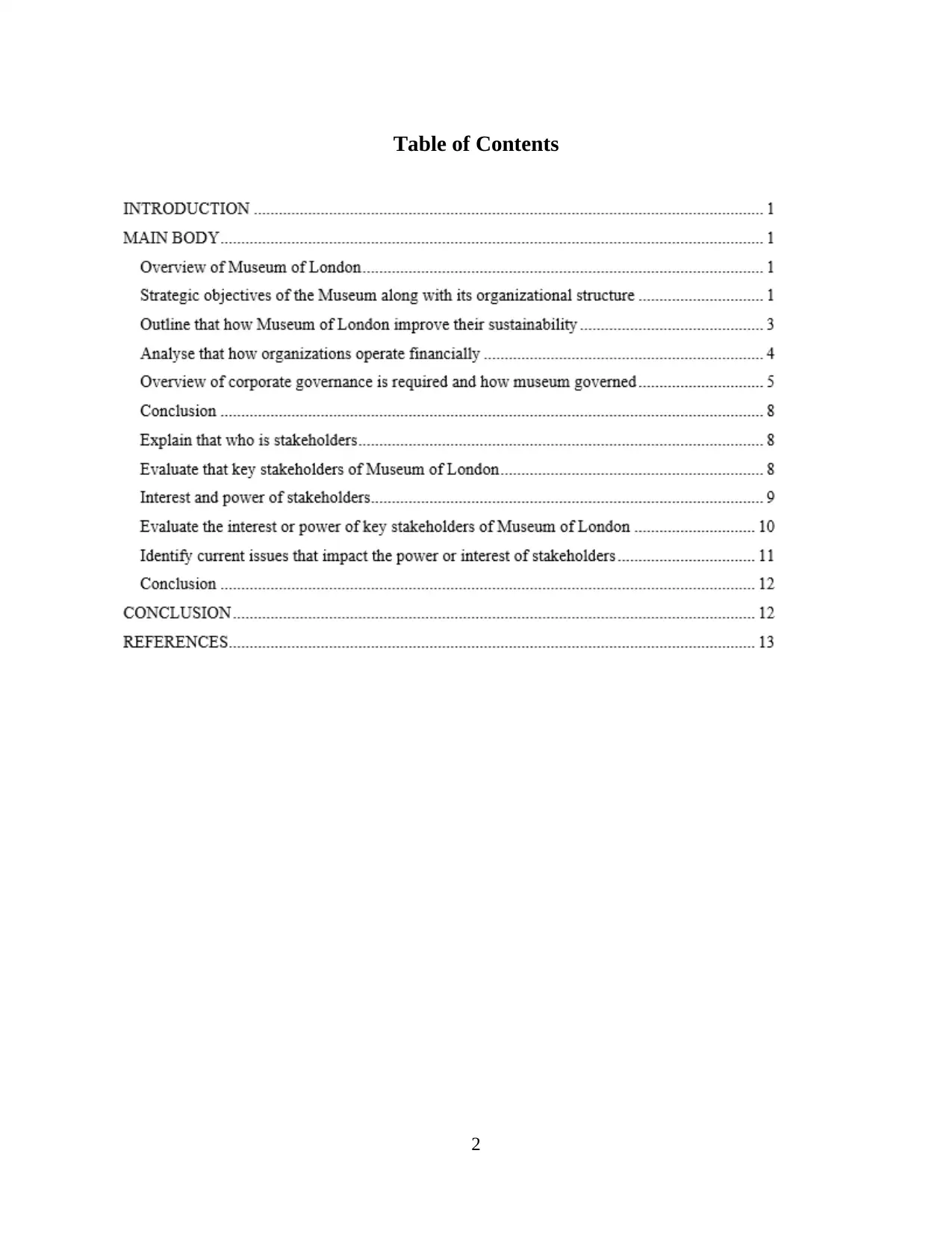
Table of Contents
2
2

INTRODUCTION
Museum of London is the place for tourist help the nation of United Kingdom to generate
more revenue and it is situated in the City of London on the London wall. Structure of the
Museum design by Philip Powell and Hidalgo Moya. Museum include the large history of urban
and having more than 6 million objects (Bailey And et.al., 2015). This paper covers the content
regarding Museum of London such as brief history, structure, objectives, sustainability and
source of funding. Along with it, it includes corporate governance which required to understand
by the members of museum. In addition, this project report includes key stakeholders of the
organization and its power & interest. Along with some current issues which impact the interest
or power of stakeholders.
MAIN BODY
Overview of Museum of London
Museum of London is the tourist place where people come to experienced culture of
London with great history of UK. This museum near to Barbican Centre and a part of Barbican
complex building. Measures of London jointly controlled by City of London Corporation and the
Greater London Authority (Museum of London, 2019). Museum of London established in 1973
by the architecture of Hidalgo Moya and Philip Powell, here they follow innovative approach to
design the structure of this museum.
Director of this organization is Sharon Ament and about 700000 visitors visit museum
annually. Organization spend around 20 Million pounds for its reinvestment and it will have
completed in 2010. Museum of London is the biggest charitable institution which is funded by
various organisations. In the whole UK nation, there are almost 2500 museums where they have
to get approval for standard management in the organization. Museum of London of and
Museum of London Dockland both are part of the same group and since 2008, these museums
are jointly funded or controlled by the City of London Corporation & Greater London Authority.
But before that, they have been controlled by the Department of Culture, Media and Sport.
Strategic objectives of the Museum along with its organizational structure
There is some objective which helps the organization to perform their task and helps in
achieving business goals. Strategic objectives are discussed below:
Main objective of Museum of London is to reach more people.
3
Museum of London is the place for tourist help the nation of United Kingdom to generate
more revenue and it is situated in the City of London on the London wall. Structure of the
Museum design by Philip Powell and Hidalgo Moya. Museum include the large history of urban
and having more than 6 million objects (Bailey And et.al., 2015). This paper covers the content
regarding Museum of London such as brief history, structure, objectives, sustainability and
source of funding. Along with it, it includes corporate governance which required to understand
by the members of museum. In addition, this project report includes key stakeholders of the
organization and its power & interest. Along with some current issues which impact the interest
or power of stakeholders.
MAIN BODY
Overview of Museum of London
Museum of London is the tourist place where people come to experienced culture of
London with great history of UK. This museum near to Barbican Centre and a part of Barbican
complex building. Measures of London jointly controlled by City of London Corporation and the
Greater London Authority (Museum of London, 2019). Museum of London established in 1973
by the architecture of Hidalgo Moya and Philip Powell, here they follow innovative approach to
design the structure of this museum.
Director of this organization is Sharon Ament and about 700000 visitors visit museum
annually. Organization spend around 20 Million pounds for its reinvestment and it will have
completed in 2010. Museum of London is the biggest charitable institution which is funded by
various organisations. In the whole UK nation, there are almost 2500 museums where they have
to get approval for standard management in the organization. Museum of London of and
Museum of London Dockland both are part of the same group and since 2008, these museums
are jointly funded or controlled by the City of London Corporation & Greater London Authority.
But before that, they have been controlled by the Department of Culture, Media and Sport.
Strategic objectives of the Museum along with its organizational structure
There is some objective which helps the organization to perform their task and helps in
achieving business goals. Strategic objectives are discussed below:
Main objective of Museum of London is to reach more people.
3
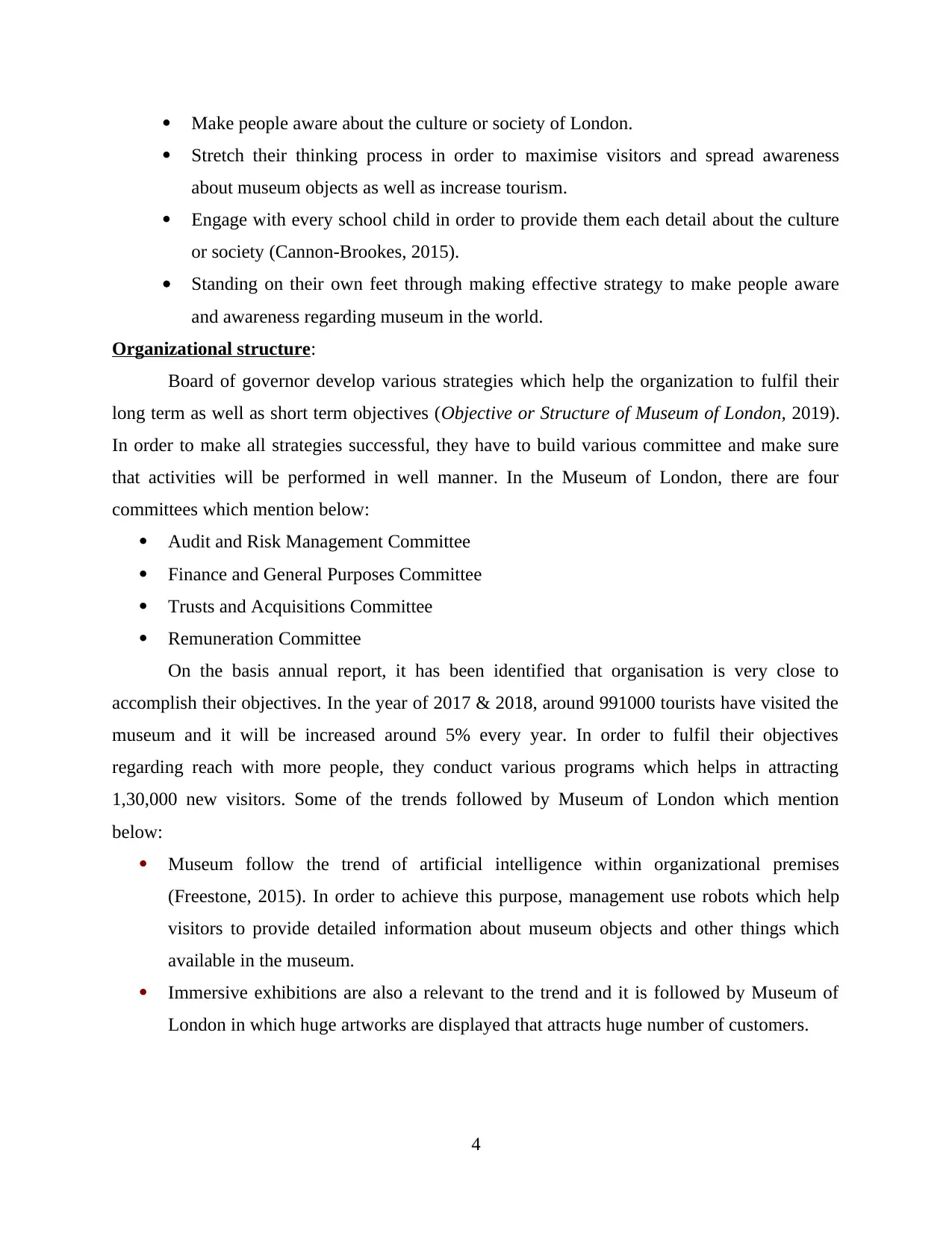
Make people aware about the culture or society of London.
Stretch their thinking process in order to maximise visitors and spread awareness
about museum objects as well as increase tourism.
Engage with every school child in order to provide them each detail about the culture
or society (Cannon-Brookes, 2015).
Standing on their own feet through making effective strategy to make people aware
and awareness regarding museum in the world.
Organizational structure:
Board of governor develop various strategies which help the organization to fulfil their
long term as well as short term objectives (Objective or Structure of Museum of London, 2019).
In order to make all strategies successful, they have to build various committee and make sure
that activities will be performed in well manner. In the Museum of London, there are four
committees which mention below:
Audit and Risk Management Committee
Finance and General Purposes Committee
Trusts and Acquisitions Committee
Remuneration Committee
On the basis annual report, it has been identified that organisation is very close to
accomplish their objectives. In the year of 2017 & 2018, around 991000 tourists have visited the
museum and it will be increased around 5% every year. In order to fulfil their objectives
regarding reach with more people, they conduct various programs which helps in attracting
1,30,000 new visitors. Some of the trends followed by Museum of London which mention
below:
Museum follow the trend of artificial intelligence within organizational premises
(Freestone, 2015). In order to achieve this purpose, management use robots which help
visitors to provide detailed information about museum objects and other things which
available in the museum.
Immersive exhibitions are also a relevant to the trend and it is followed by Museum of
London in which huge artworks are displayed that attracts huge number of customers.
4
Stretch their thinking process in order to maximise visitors and spread awareness
about museum objects as well as increase tourism.
Engage with every school child in order to provide them each detail about the culture
or society (Cannon-Brookes, 2015).
Standing on their own feet through making effective strategy to make people aware
and awareness regarding museum in the world.
Organizational structure:
Board of governor develop various strategies which help the organization to fulfil their
long term as well as short term objectives (Objective or Structure of Museum of London, 2019).
In order to make all strategies successful, they have to build various committee and make sure
that activities will be performed in well manner. In the Museum of London, there are four
committees which mention below:
Audit and Risk Management Committee
Finance and General Purposes Committee
Trusts and Acquisitions Committee
Remuneration Committee
On the basis annual report, it has been identified that organisation is very close to
accomplish their objectives. In the year of 2017 & 2018, around 991000 tourists have visited the
museum and it will be increased around 5% every year. In order to fulfil their objectives
regarding reach with more people, they conduct various programs which helps in attracting
1,30,000 new visitors. Some of the trends followed by Museum of London which mention
below:
Museum follow the trend of artificial intelligence within organizational premises
(Freestone, 2015). In order to achieve this purpose, management use robots which help
visitors to provide detailed information about museum objects and other things which
available in the museum.
Immersive exhibitions are also a relevant to the trend and it is followed by Museum of
London in which huge artworks are displayed that attracts huge number of customers.
4
Secure Best Marks with AI Grader
Need help grading? Try our AI Grader for instant feedback on your assignments.
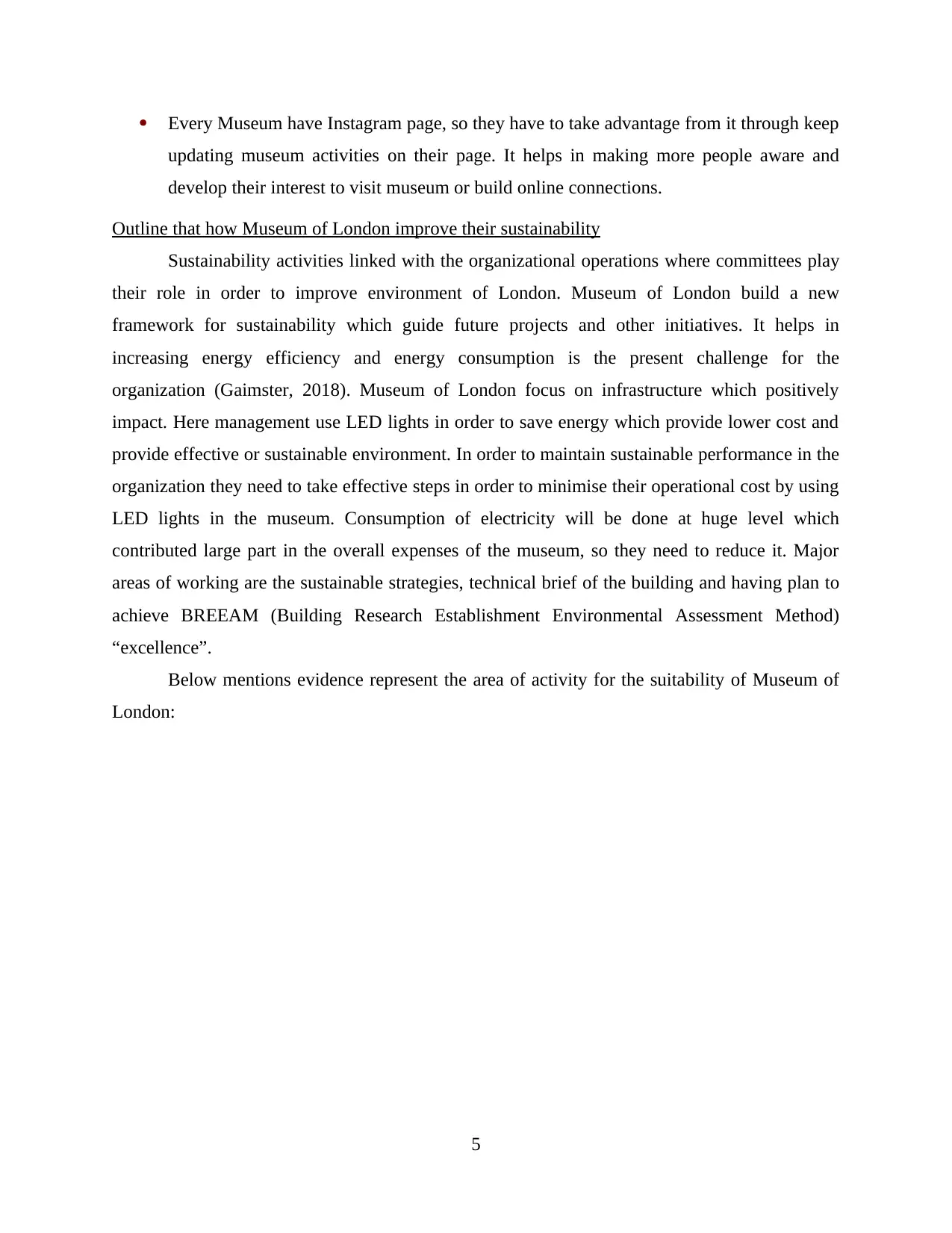
Every Museum have Instagram page, so they have to take advantage from it through keep
updating museum activities on their page. It helps in making more people aware and
develop their interest to visit museum or build online connections.
Outline that how Museum of London improve their sustainability
Sustainability activities linked with the organizational operations where committees play
their role in order to improve environment of London. Museum of London build a new
framework for sustainability which guide future projects and other initiatives. It helps in
increasing energy efficiency and energy consumption is the present challenge for the
organization (Gaimster, 2018). Museum of London focus on infrastructure which positively
impact. Here management use LED lights in order to save energy which provide lower cost and
provide effective or sustainable environment. In order to maintain sustainable performance in the
organization they need to take effective steps in order to minimise their operational cost by using
LED lights in the museum. Consumption of electricity will be done at huge level which
contributed large part in the overall expenses of the museum, so they need to reduce it. Major
areas of working are the sustainable strategies, technical brief of the building and having plan to
achieve BREEAM (Building Research Establishment Environmental Assessment Method)
“excellence”.
Below mentions evidence represent the area of activity for the suitability of Museum of
London:
5
updating museum activities on their page. It helps in making more people aware and
develop their interest to visit museum or build online connections.
Outline that how Museum of London improve their sustainability
Sustainability activities linked with the organizational operations where committees play
their role in order to improve environment of London. Museum of London build a new
framework for sustainability which guide future projects and other initiatives. It helps in
increasing energy efficiency and energy consumption is the present challenge for the
organization (Gaimster, 2018). Museum of London focus on infrastructure which positively
impact. Here management use LED lights in order to save energy which provide lower cost and
provide effective or sustainable environment. In order to maintain sustainable performance in the
organization they need to take effective steps in order to minimise their operational cost by using
LED lights in the museum. Consumption of electricity will be done at huge level which
contributed large part in the overall expenses of the museum, so they need to reduce it. Major
areas of working are the sustainable strategies, technical brief of the building and having plan to
achieve BREEAM (Building Research Establishment Environmental Assessment Method)
“excellence”.
Below mentions evidence represent the area of activity for the suitability of Museum of
London:
5
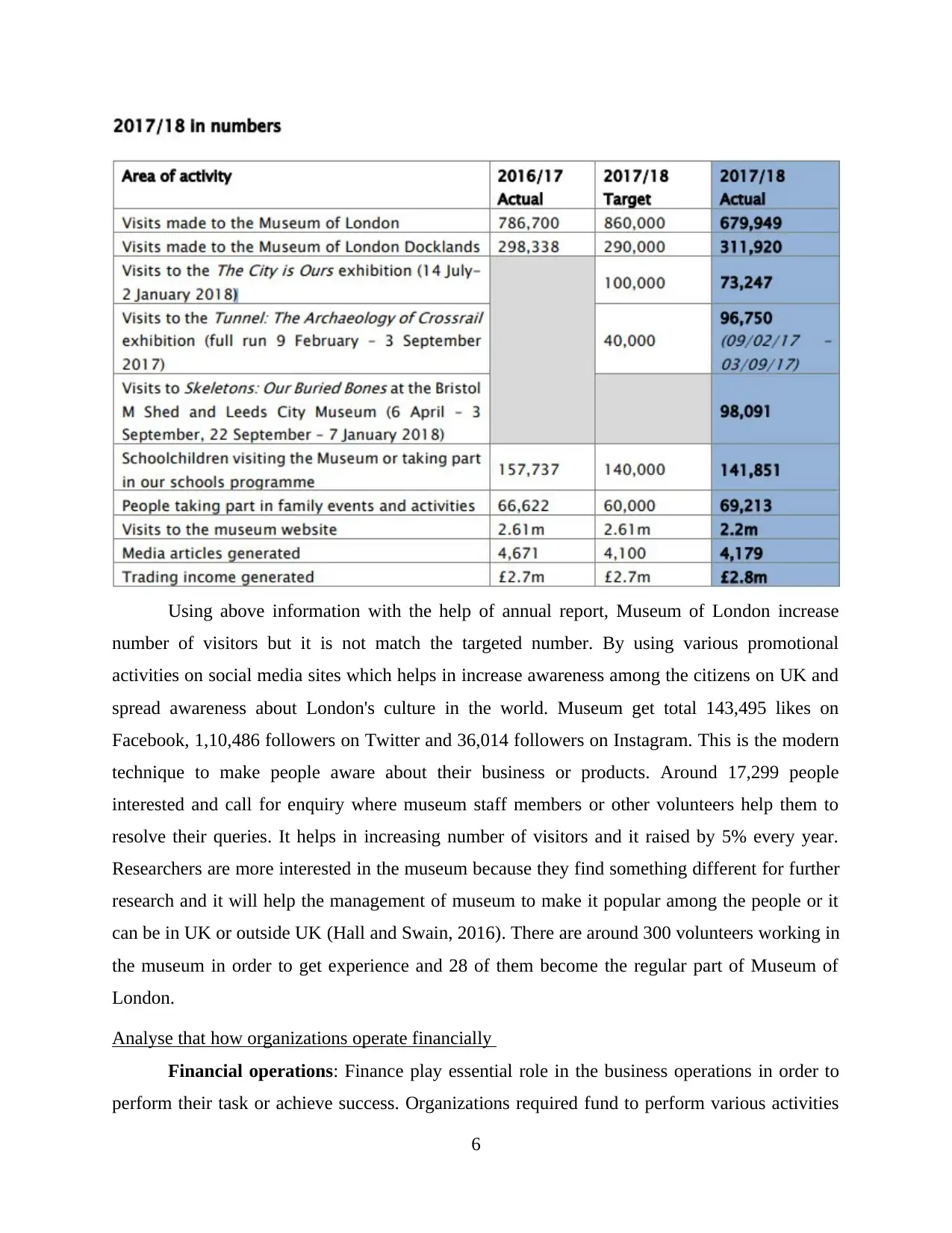
Using above information with the help of annual report, Museum of London increase
number of visitors but it is not match the targeted number. By using various promotional
activities on social media sites which helps in increase awareness among the citizens on UK and
spread awareness about London's culture in the world. Museum get total 143,495 likes on
Facebook, 1,10,486 followers on Twitter and 36,014 followers on Instagram. This is the modern
technique to make people aware about their business or products. Around 17,299 people
interested and call for enquiry where museum staff members or other volunteers help them to
resolve their queries. It helps in increasing number of visitors and it raised by 5% every year.
Researchers are more interested in the museum because they find something different for further
research and it will help the management of museum to make it popular among the people or it
can be in UK or outside UK (Hall and Swain, 2016). There are around 300 volunteers working in
the museum in order to get experience and 28 of them become the regular part of Museum of
London.
Analyse that how organizations operate financially
Financial operations: Finance play essential role in the business operations in order to
perform their task or achieve success. Organizations required fund to perform various activities
6
number of visitors but it is not match the targeted number. By using various promotional
activities on social media sites which helps in increase awareness among the citizens on UK and
spread awareness about London's culture in the world. Museum get total 143,495 likes on
Facebook, 1,10,486 followers on Twitter and 36,014 followers on Instagram. This is the modern
technique to make people aware about their business or products. Around 17,299 people
interested and call for enquiry where museum staff members or other volunteers help them to
resolve their queries. It helps in increasing number of visitors and it raised by 5% every year.
Researchers are more interested in the museum because they find something different for further
research and it will help the management of museum to make it popular among the people or it
can be in UK or outside UK (Hall and Swain, 2016). There are around 300 volunteers working in
the museum in order to get experience and 28 of them become the regular part of Museum of
London.
Analyse that how organizations operate financially
Financial operations: Finance play essential role in the business operations in order to
perform their task or achieve success. Organizations required fund to perform various activities
6
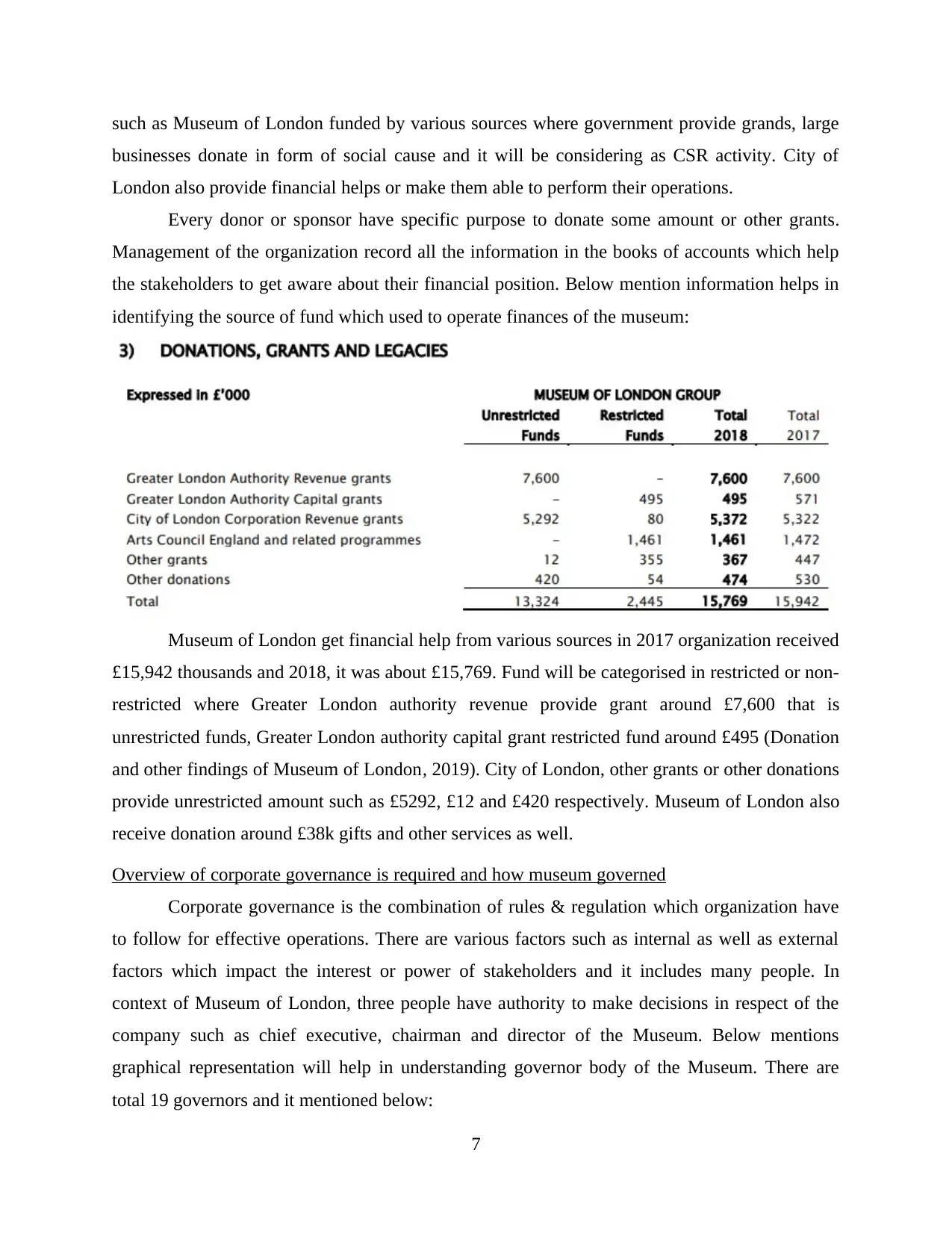
such as Museum of London funded by various sources where government provide grands, large
businesses donate in form of social cause and it will be considering as CSR activity. City of
London also provide financial helps or make them able to perform their operations.
Every donor or sponsor have specific purpose to donate some amount or other grants.
Management of the organization record all the information in the books of accounts which help
the stakeholders to get aware about their financial position. Below mention information helps in
identifying the source of fund which used to operate finances of the museum:
Museum of London get financial help from various sources in 2017 organization received
£15,942 thousands and 2018, it was about £15,769. Fund will be categorised in restricted or non-
restricted where Greater London authority revenue provide grant around £7,600 that is
unrestricted funds, Greater London authority capital grant restricted fund around £495 (Donation
and other findings of Museum of London, 2019). City of London, other grants or other donations
provide unrestricted amount such as £5292, £12 and £420 respectively. Museum of London also
receive donation around £38k gifts and other services as well.
Overview of corporate governance is required and how museum governed
Corporate governance is the combination of rules & regulation which organization have
to follow for effective operations. There are various factors such as internal as well as external
factors which impact the interest or power of stakeholders and it includes many people. In
context of Museum of London, three people have authority to make decisions in respect of the
company such as chief executive, chairman and director of the Museum. Below mentions
graphical representation will help in understanding governor body of the Museum. There are
total 19 governors and it mentioned below:
7
businesses donate in form of social cause and it will be considering as CSR activity. City of
London also provide financial helps or make them able to perform their operations.
Every donor or sponsor have specific purpose to donate some amount or other grants.
Management of the organization record all the information in the books of accounts which help
the stakeholders to get aware about their financial position. Below mention information helps in
identifying the source of fund which used to operate finances of the museum:
Museum of London get financial help from various sources in 2017 organization received
£15,942 thousands and 2018, it was about £15,769. Fund will be categorised in restricted or non-
restricted where Greater London authority revenue provide grant around £7,600 that is
unrestricted funds, Greater London authority capital grant restricted fund around £495 (Donation
and other findings of Museum of London, 2019). City of London, other grants or other donations
provide unrestricted amount such as £5292, £12 and £420 respectively. Museum of London also
receive donation around £38k gifts and other services as well.
Overview of corporate governance is required and how museum governed
Corporate governance is the combination of rules & regulation which organization have
to follow for effective operations. There are various factors such as internal as well as external
factors which impact the interest or power of stakeholders and it includes many people. In
context of Museum of London, three people have authority to make decisions in respect of the
company such as chief executive, chairman and director of the Museum. Below mentions
graphical representation will help in understanding governor body of the Museum. There are
total 19 governors and it mentioned below:
7
Paraphrase This Document
Need a fresh take? Get an instant paraphrase of this document with our AI Paraphraser
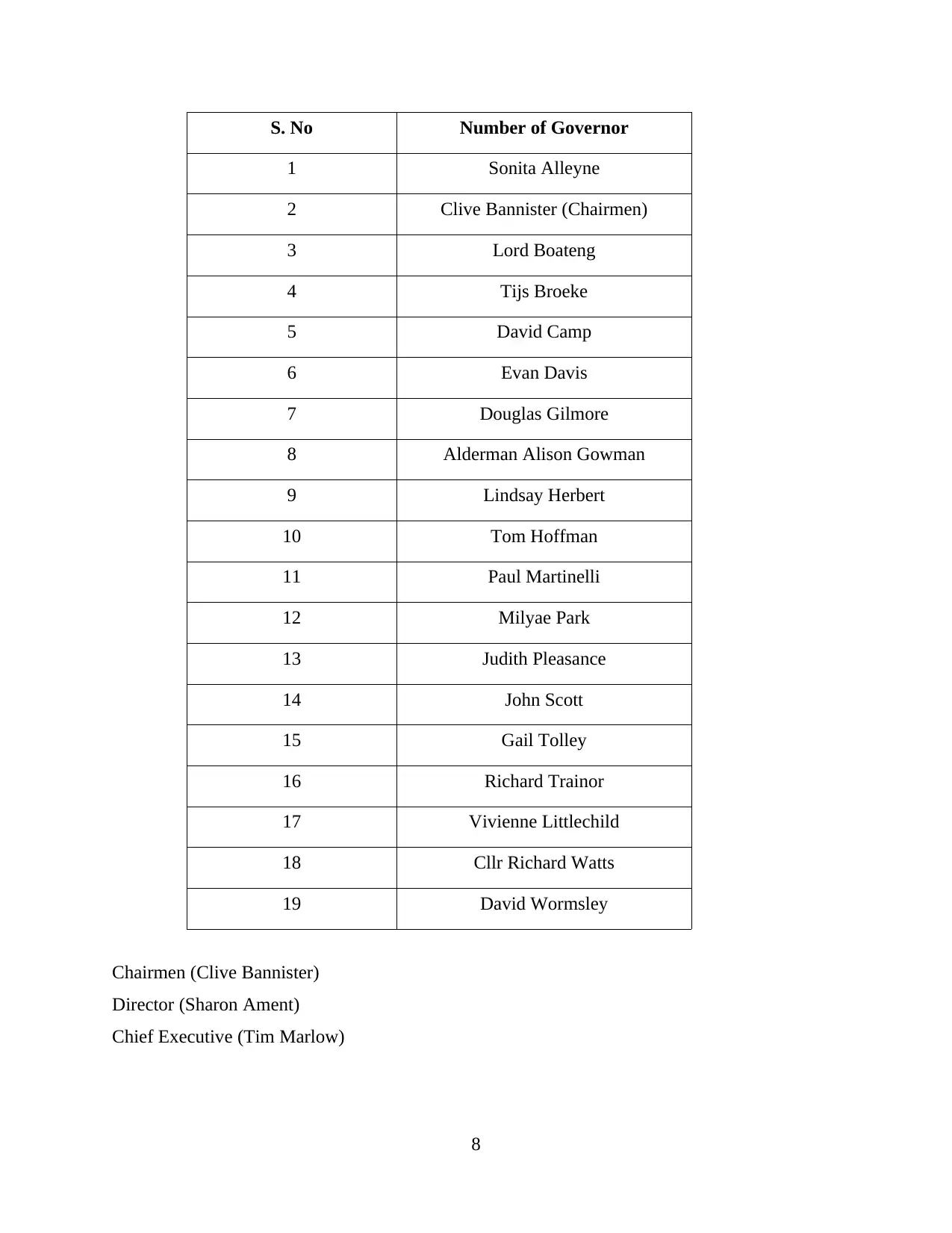
S. No Number of Governor
1 Sonita Alleyne
2 Clive Bannister (Chairmen)
3 Lord Boateng
4 Tijs Broeke
5 David Camp
6 Evan Davis
7 Douglas Gilmore
8 Alderman Alison Gowman
9 Lindsay Herbert
10 Tom Hoffman
11 Paul Martinelli
12 Milyae Park
13 Judith Pleasance
14 John Scott
15 Gail Tolley
16 Richard Trainor
17 Vivienne Littlechild
18 Cllr Richard Watts
19 David Wormsley
Chairmen (Clive Bannister)
Director (Sharon Ament)
Chief Executive (Tim Marlow)
8
1 Sonita Alleyne
2 Clive Bannister (Chairmen)
3 Lord Boateng
4 Tijs Broeke
5 David Camp
6 Evan Davis
7 Douglas Gilmore
8 Alderman Alison Gowman
9 Lindsay Herbert
10 Tom Hoffman
11 Paul Martinelli
12 Milyae Park
13 Judith Pleasance
14 John Scott
15 Gail Tolley
16 Richard Trainor
17 Vivienne Littlechild
18 Cllr Richard Watts
19 David Wormsley
Chairmen (Clive Bannister)
Director (Sharon Ament)
Chief Executive (Tim Marlow)
8

Above mention objectives formulated by the top management people which mention in
above diagram (Humphrey, 2015). At the time of developing organizational goals, they have to
analyse current position or situation of the company. High authority people follow various
corporate practices which discussed below:
Done work in ethical way comes under code of ethics that is main practice of the
corporate governance. In context of Museum of London, management make sure to
follow all the standards and rules accordingly.
It is an national museums so it will be funded by various organisations. So it is very
important to show each and every detail about funding to their stakeholders which create
transparency among the museum or customer of it.
9
Museu
m of
Londo
n
Chair
men
(Clive
Bannis
ter)
Chief
Execut
ive
(Tim
Marlo
w)
Gover
nors
Direct
or
(Sharo
n
Ament
)
Sonita
Alleyn
e
Clive
Bannis
ter
(Chair
men)
Lord
Boaten
g
Tijs
Broek
e
David
Camp
Evan
Davis
Dougl
as
Gilmo
re
Alder
man
Alison
Gowm
an
Lindsa
y
Herber
t
Tom
Hoffm
an
Paul
Martin
elli
Milyae
Park
Judith
Pleasa
nce
John
Scot
t
Gail
Toll
ey
Rich
ard
Trai
nor
Vivi
enne
Littl
echi
ld
Cllr
Rich
ard
Watt
s
Dav
id
Wor
msle
y
above diagram (Humphrey, 2015). At the time of developing organizational goals, they have to
analyse current position or situation of the company. High authority people follow various
corporate practices which discussed below:
Done work in ethical way comes under code of ethics that is main practice of the
corporate governance. In context of Museum of London, management make sure to
follow all the standards and rules accordingly.
It is an national museums so it will be funded by various organisations. So it is very
important to show each and every detail about funding to their stakeholders which create
transparency among the museum or customer of it.
9
Museu
m of
Londo
n
Chair
men
(Clive
Bannis
ter)
Chief
Execut
ive
(Tim
Marlo
w)
Gover
nors
Direct
or
(Sharo
n
Ament
)
Sonita
Alleyn
e
Clive
Bannis
ter
(Chair
men)
Lord
Boaten
g
Tijs
Broek
e
David
Camp
Evan
Davis
Dougl
as
Gilmo
re
Alder
man
Alison
Gowm
an
Lindsa
y
Herber
t
Tom
Hoffm
an
Paul
Martin
elli
Milyae
Park
Judith
Pleasa
nce
John
Scot
t
Gail
Toll
ey
Rich
ard
Trai
nor
Vivi
enne
Littl
echi
ld
Cllr
Rich
ard
Watt
s
Dav
id
Wor
msle
y
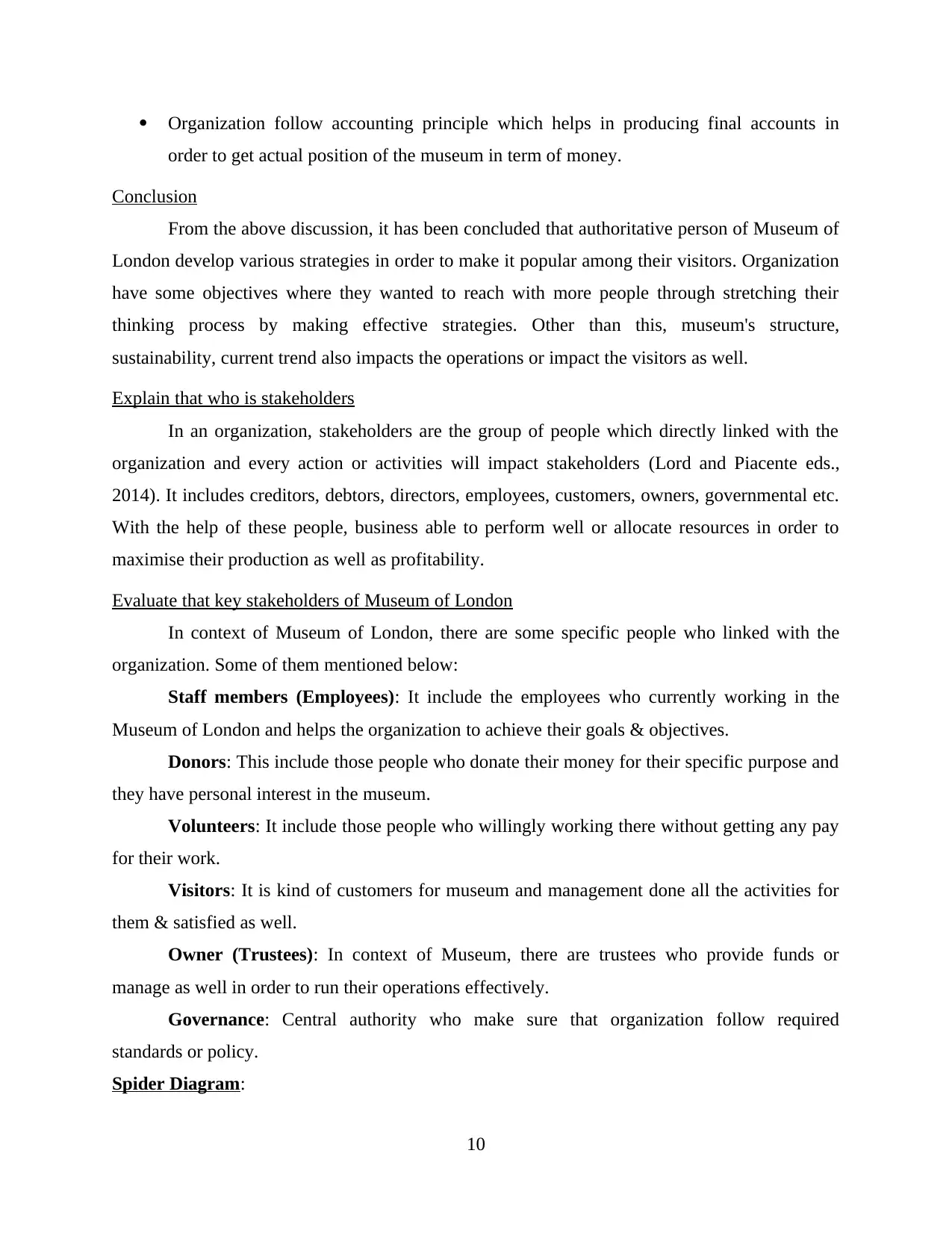
Organization follow accounting principle which helps in producing final accounts in
order to get actual position of the museum in term of money.
Conclusion
From the above discussion, it has been concluded that authoritative person of Museum of
London develop various strategies in order to make it popular among their visitors. Organization
have some objectives where they wanted to reach with more people through stretching their
thinking process by making effective strategies. Other than this, museum's structure,
sustainability, current trend also impacts the operations or impact the visitors as well.
Explain that who is stakeholders
In an organization, stakeholders are the group of people which directly linked with the
organization and every action or activities will impact stakeholders (Lord and Piacente eds.,
2014). It includes creditors, debtors, directors, employees, customers, owners, governmental etc.
With the help of these people, business able to perform well or allocate resources in order to
maximise their production as well as profitability.
Evaluate that key stakeholders of Museum of London
In context of Museum of London, there are some specific people who linked with the
organization. Some of them mentioned below:
Staff members (Employees): It include the employees who currently working in the
Museum of London and helps the organization to achieve their goals & objectives.
Donors: This include those people who donate their money for their specific purpose and
they have personal interest in the museum.
Volunteers: It include those people who willingly working there without getting any pay
for their work.
Visitors: It is kind of customers for museum and management done all the activities for
them & satisfied as well.
Owner (Trustees): In context of Museum, there are trustees who provide funds or
manage as well in order to run their operations effectively.
Governance: Central authority who make sure that organization follow required
standards or policy.
Spider Diagram:
10
order to get actual position of the museum in term of money.
Conclusion
From the above discussion, it has been concluded that authoritative person of Museum of
London develop various strategies in order to make it popular among their visitors. Organization
have some objectives where they wanted to reach with more people through stretching their
thinking process by making effective strategies. Other than this, museum's structure,
sustainability, current trend also impacts the operations or impact the visitors as well.
Explain that who is stakeholders
In an organization, stakeholders are the group of people which directly linked with the
organization and every action or activities will impact stakeholders (Lord and Piacente eds.,
2014). It includes creditors, debtors, directors, employees, customers, owners, governmental etc.
With the help of these people, business able to perform well or allocate resources in order to
maximise their production as well as profitability.
Evaluate that key stakeholders of Museum of London
In context of Museum of London, there are some specific people who linked with the
organization. Some of them mentioned below:
Staff members (Employees): It include the employees who currently working in the
Museum of London and helps the organization to achieve their goals & objectives.
Donors: This include those people who donate their money for their specific purpose and
they have personal interest in the museum.
Volunteers: It include those people who willingly working there without getting any pay
for their work.
Visitors: It is kind of customers for museum and management done all the activities for
them & satisfied as well.
Owner (Trustees): In context of Museum, there are trustees who provide funds or
manage as well in order to run their operations effectively.
Governance: Central authority who make sure that organization follow required
standards or policy.
Spider Diagram:
10
Secure Best Marks with AI Grader
Need help grading? Try our AI Grader for instant feedback on your assignments.
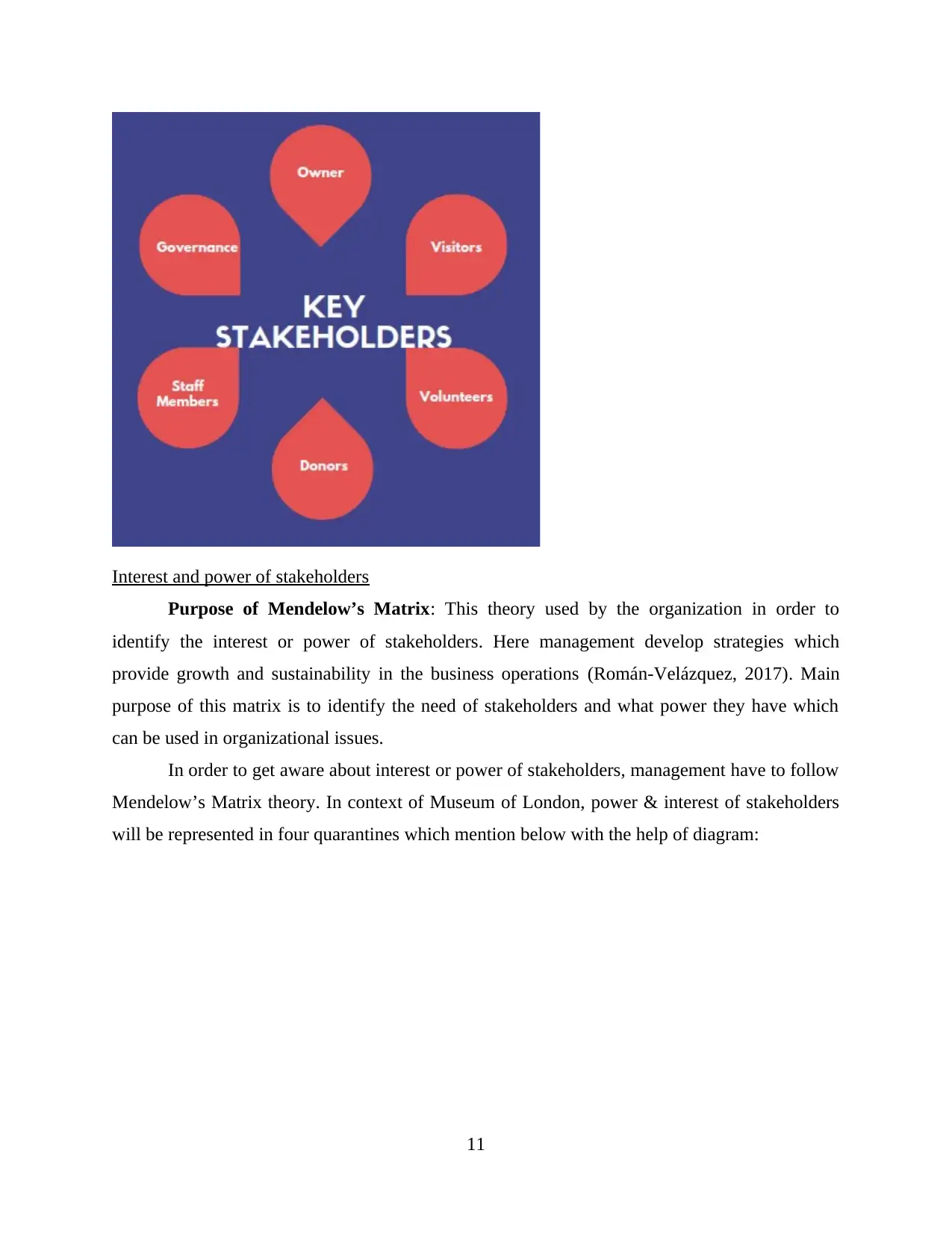
Interest and power of stakeholders
Purpose of Mendelow’s Matrix: This theory used by the organization in order to
identify the interest or power of stakeholders. Here management develop strategies which
provide growth and sustainability in the business operations (Román-Velázquez, 2017). Main
purpose of this matrix is to identify the need of stakeholders and what power they have which
can be used in organizational issues.
In order to get aware about interest or power of stakeholders, management have to follow
Mendelow’s Matrix theory. In context of Museum of London, power & interest of stakeholders
will be represented in four quarantines which mention below with the help of diagram:
11
Purpose of Mendelow’s Matrix: This theory used by the organization in order to
identify the interest or power of stakeholders. Here management develop strategies which
provide growth and sustainability in the business operations (Román-Velázquez, 2017). Main
purpose of this matrix is to identify the need of stakeholders and what power they have which
can be used in organizational issues.
In order to get aware about interest or power of stakeholders, management have to follow
Mendelow’s Matrix theory. In context of Museum of London, power & interest of stakeholders
will be represented in four quarantines which mention below with the help of diagram:
11
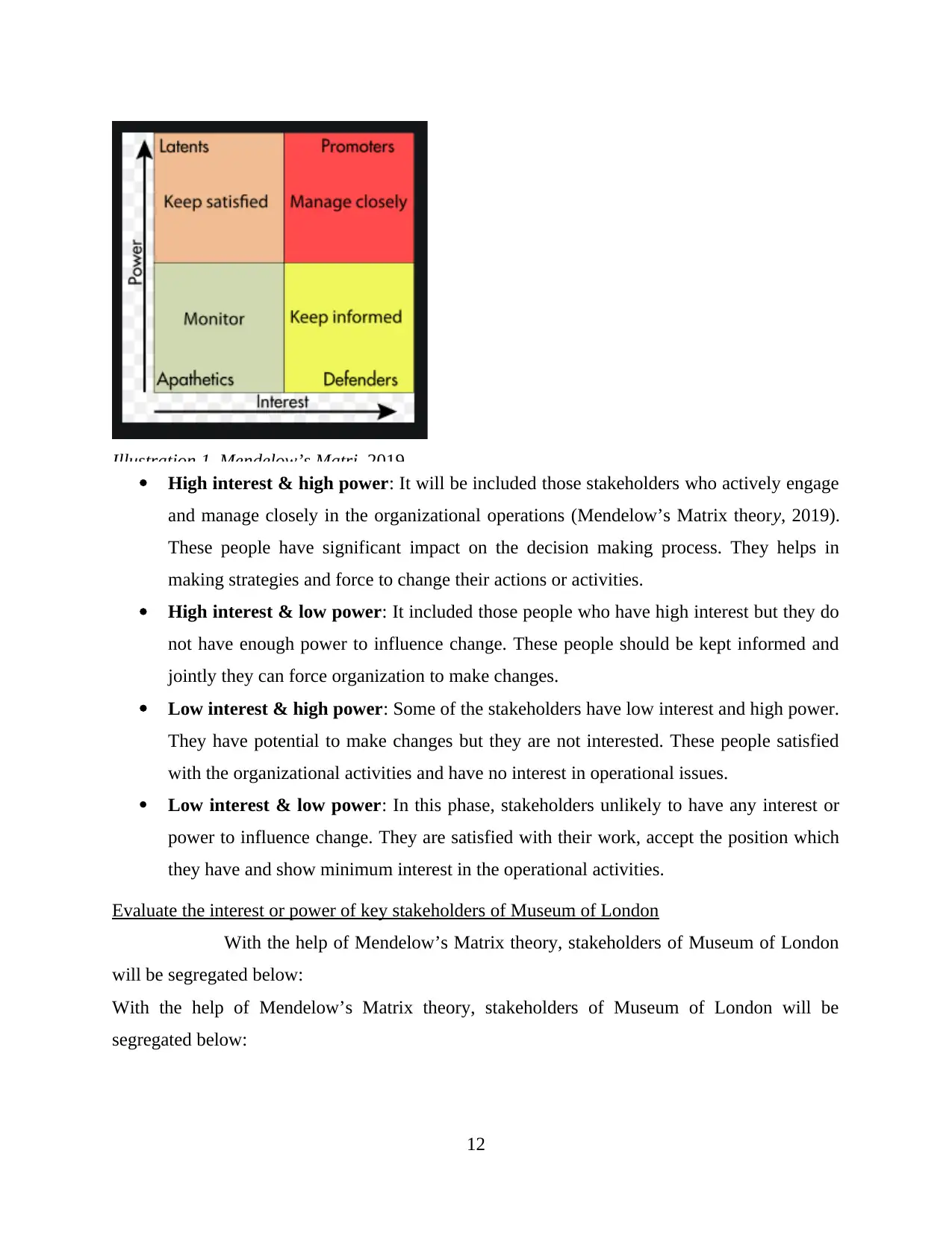
Illustration 1 Mendelow’s Matri, 2019.
High interest & high power: It will be included those stakeholders who actively engage
and manage closely in the organizational operations (Mendelow’s Matrix theory, 2019).
These people have significant impact on the decision making process. They helps in
making strategies and force to change their actions or activities.
High interest & low power: It included those people who have high interest but they do
not have enough power to influence change. These people should be kept informed and
jointly they can force organization to make changes.
Low interest & high power: Some of the stakeholders have low interest and high power.
They have potential to make changes but they are not interested. These people satisfied
with the organizational activities and have no interest in operational issues.
Low interest & low power: In this phase, stakeholders unlikely to have any interest or
power to influence change. They are satisfied with their work, accept the position which
they have and show minimum interest in the operational activities.
Evaluate the interest or power of key stakeholders of Museum of London
With the help of Mendelow’s Matrix theory, stakeholders of Museum of London
will be segregated below:
With the help of Mendelow’s Matrix theory, stakeholders of Museum of London will be
segregated below:
12
High interest & high power: It will be included those stakeholders who actively engage
and manage closely in the organizational operations (Mendelow’s Matrix theory, 2019).
These people have significant impact on the decision making process. They helps in
making strategies and force to change their actions or activities.
High interest & low power: It included those people who have high interest but they do
not have enough power to influence change. These people should be kept informed and
jointly they can force organization to make changes.
Low interest & high power: Some of the stakeholders have low interest and high power.
They have potential to make changes but they are not interested. These people satisfied
with the organizational activities and have no interest in operational issues.
Low interest & low power: In this phase, stakeholders unlikely to have any interest or
power to influence change. They are satisfied with their work, accept the position which
they have and show minimum interest in the operational activities.
Evaluate the interest or power of key stakeholders of Museum of London
With the help of Mendelow’s Matrix theory, stakeholders of Museum of London
will be segregated below:
With the help of Mendelow’s Matrix theory, stakeholders of Museum of London will be
segregated below:
12
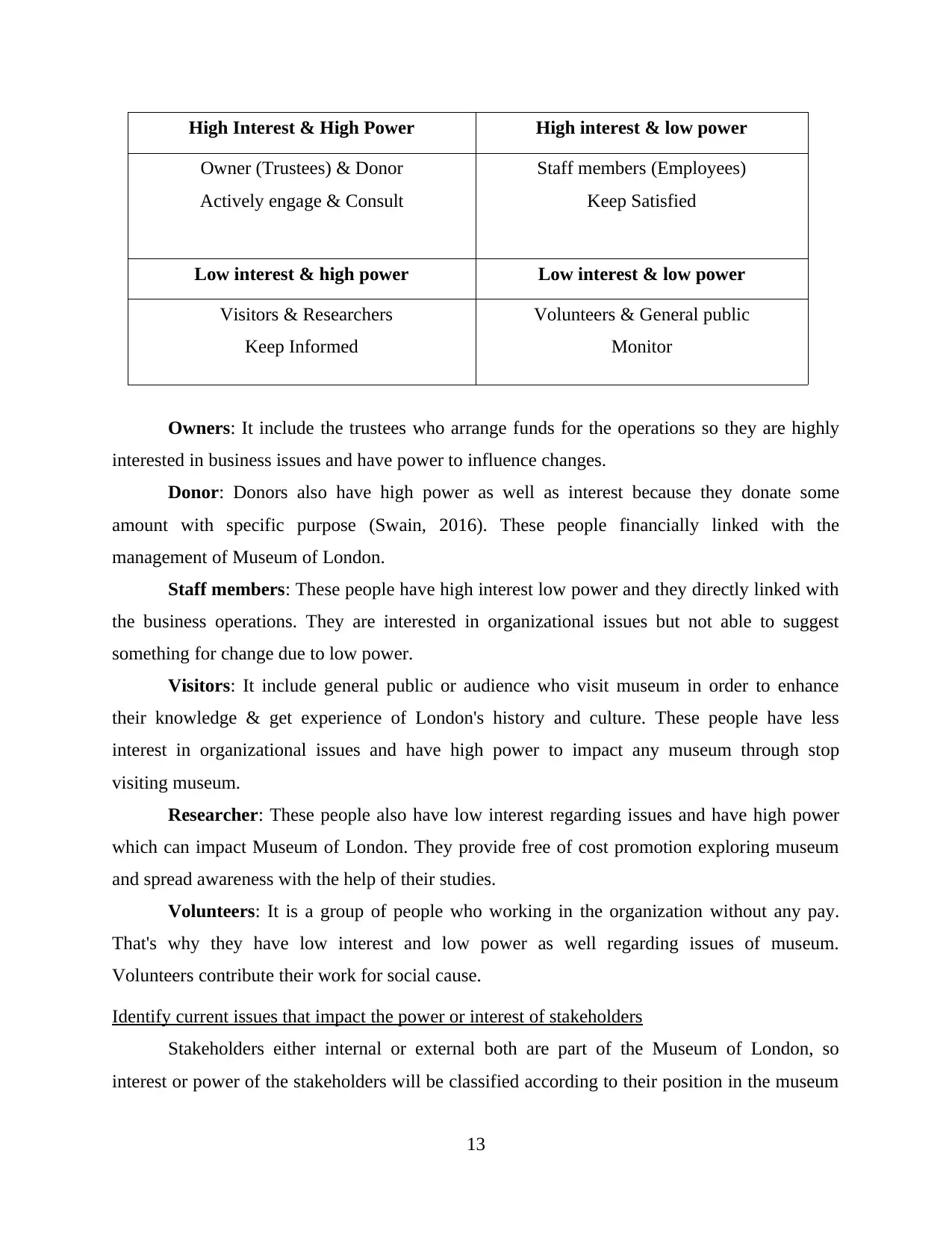
High Interest & High Power High interest & low power
Owner (Trustees) & Donor
Actively engage & Consult
Staff members (Employees)
Keep Satisfied
Low interest & high power Low interest & low power
Visitors & Researchers
Keep Informed
Volunteers & General public
Monitor
Owners: It include the trustees who arrange funds for the operations so they are highly
interested in business issues and have power to influence changes.
Donor: Donors also have high power as well as interest because they donate some
amount with specific purpose (Swain, 2016). These people financially linked with the
management of Museum of London.
Staff members: These people have high interest low power and they directly linked with
the business operations. They are interested in organizational issues but not able to suggest
something for change due to low power.
Visitors: It include general public or audience who visit museum in order to enhance
their knowledge & get experience of London's history and culture. These people have less
interest in organizational issues and have high power to impact any museum through stop
visiting museum.
Researcher: These people also have low interest regarding issues and have high power
which can impact Museum of London. They provide free of cost promotion exploring museum
and spread awareness with the help of their studies.
Volunteers: It is a group of people who working in the organization without any pay.
That's why they have low interest and low power as well regarding issues of museum.
Volunteers contribute their work for social cause.
Identify current issues that impact the power or interest of stakeholders
Stakeholders either internal or external both are part of the Museum of London, so
interest or power of the stakeholders will be classified according to their position in the museum
13
Owner (Trustees) & Donor
Actively engage & Consult
Staff members (Employees)
Keep Satisfied
Low interest & high power Low interest & low power
Visitors & Researchers
Keep Informed
Volunteers & General public
Monitor
Owners: It include the trustees who arrange funds for the operations so they are highly
interested in business issues and have power to influence changes.
Donor: Donors also have high power as well as interest because they donate some
amount with specific purpose (Swain, 2016). These people financially linked with the
management of Museum of London.
Staff members: These people have high interest low power and they directly linked with
the business operations. They are interested in organizational issues but not able to suggest
something for change due to low power.
Visitors: It include general public or audience who visit museum in order to enhance
their knowledge & get experience of London's history and culture. These people have less
interest in organizational issues and have high power to impact any museum through stop
visiting museum.
Researcher: These people also have low interest regarding issues and have high power
which can impact Museum of London. They provide free of cost promotion exploring museum
and spread awareness with the help of their studies.
Volunteers: It is a group of people who working in the organization without any pay.
That's why they have low interest and low power as well regarding issues of museum.
Volunteers contribute their work for social cause.
Identify current issues that impact the power or interest of stakeholders
Stakeholders either internal or external both are part of the Museum of London, so
interest or power of the stakeholders will be classified according to their position in the museum
13
Paraphrase This Document
Need a fresh take? Get an instant paraphrase of this document with our AI Paraphraser
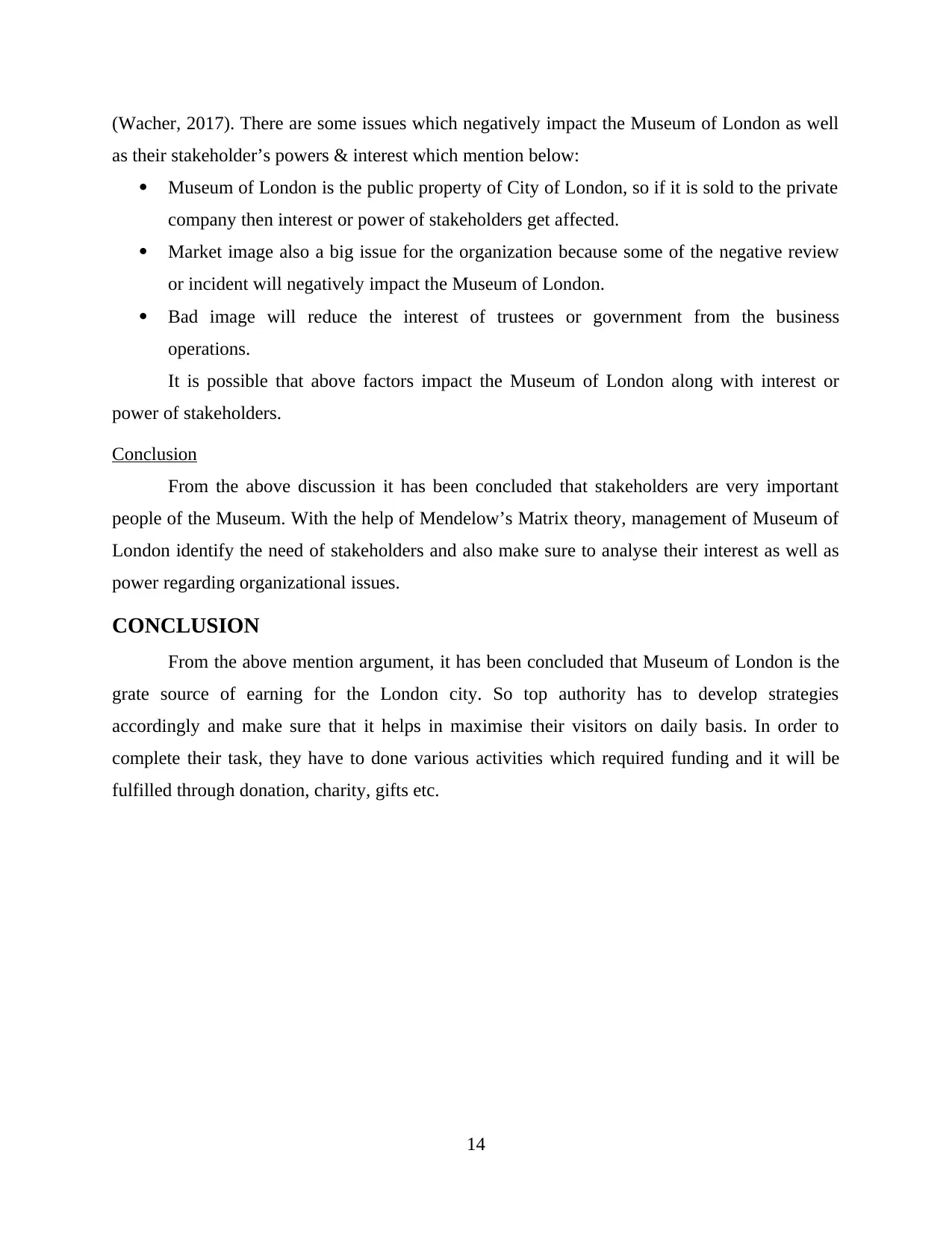
(Wacher, 2017). There are some issues which negatively impact the Museum of London as well
as their stakeholder’s powers & interest which mention below:
Museum of London is the public property of City of London, so if it is sold to the private
company then interest or power of stakeholders get affected.
Market image also a big issue for the organization because some of the negative review
or incident will negatively impact the Museum of London.
Bad image will reduce the interest of trustees or government from the business
operations.
It is possible that above factors impact the Museum of London along with interest or
power of stakeholders.
Conclusion
From the above discussion it has been concluded that stakeholders are very important
people of the Museum. With the help of Mendelow’s Matrix theory, management of Museum of
London identify the need of stakeholders and also make sure to analyse their interest as well as
power regarding organizational issues.
CONCLUSION
From the above mention argument, it has been concluded that Museum of London is the
grate source of earning for the London city. So top authority has to develop strategies
accordingly and make sure that it helps in maximise their visitors on daily basis. In order to
complete their task, they have to done various activities which required funding and it will be
fulfilled through donation, charity, gifts etc.
14
as their stakeholder’s powers & interest which mention below:
Museum of London is the public property of City of London, so if it is sold to the private
company then interest or power of stakeholders get affected.
Market image also a big issue for the organization because some of the negative review
or incident will negatively impact the Museum of London.
Bad image will reduce the interest of trustees or government from the business
operations.
It is possible that above factors impact the Museum of London along with interest or
power of stakeholders.
Conclusion
From the above discussion it has been concluded that stakeholders are very important
people of the Museum. With the help of Mendelow’s Matrix theory, management of Museum of
London identify the need of stakeholders and also make sure to analyse their interest as well as
power regarding organizational issues.
CONCLUSION
From the above mention argument, it has been concluded that Museum of London is the
grate source of earning for the London city. So top authority has to develop strategies
accordingly and make sure that it helps in maximise their visitors on daily basis. In order to
complete their task, they have to done various activities which required funding and it will be
fulfilled through donation, charity, gifts etc.
14
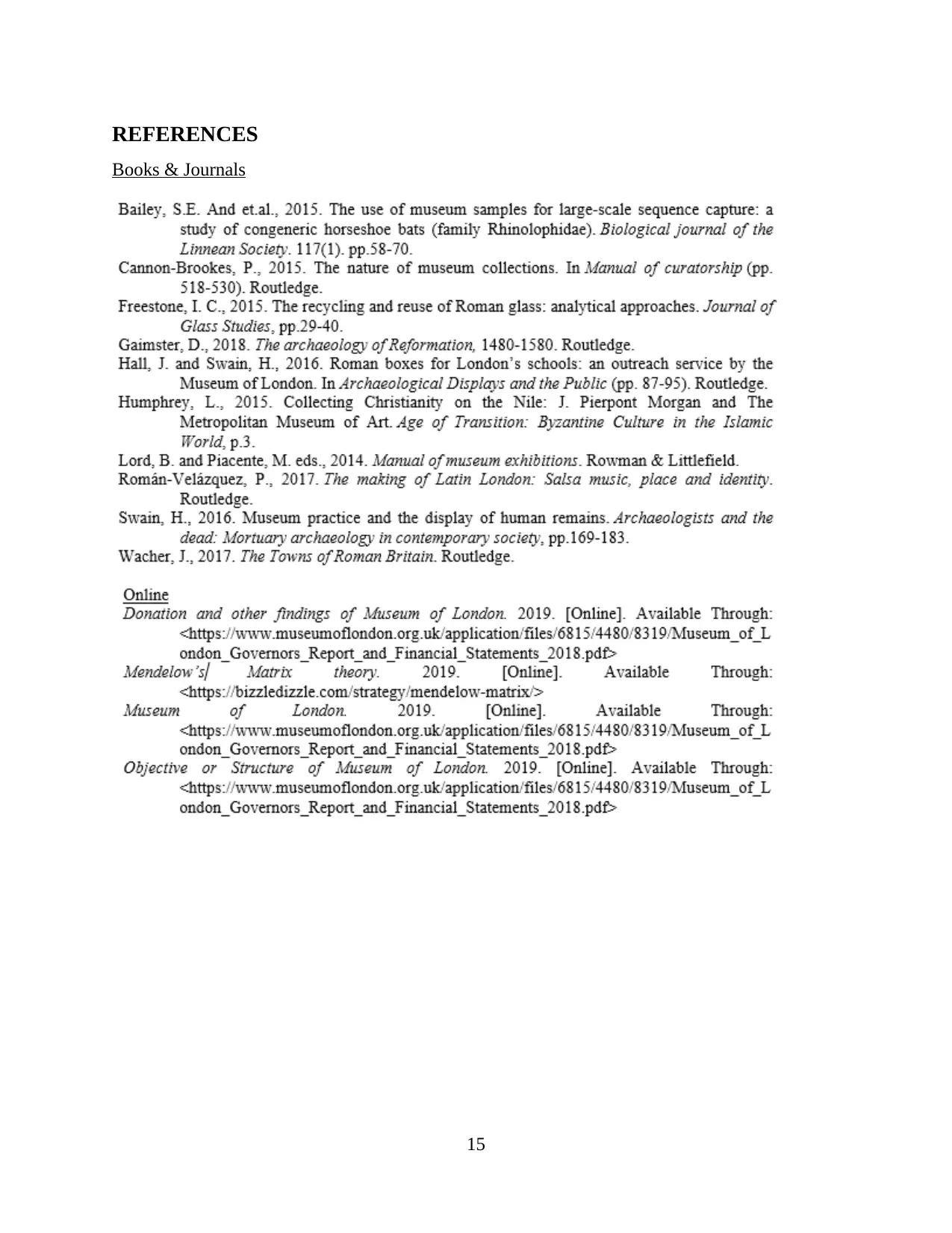
REFERENCES
Books & Journals
15
Books & Journals
15

16
1 out of 16
Related Documents
Your All-in-One AI-Powered Toolkit for Academic Success.
+13062052269
info@desklib.com
Available 24*7 on WhatsApp / Email
![[object Object]](/_next/static/media/star-bottom.7253800d.svg)
Unlock your academic potential
© 2024 | Zucol Services PVT LTD | All rights reserved.





